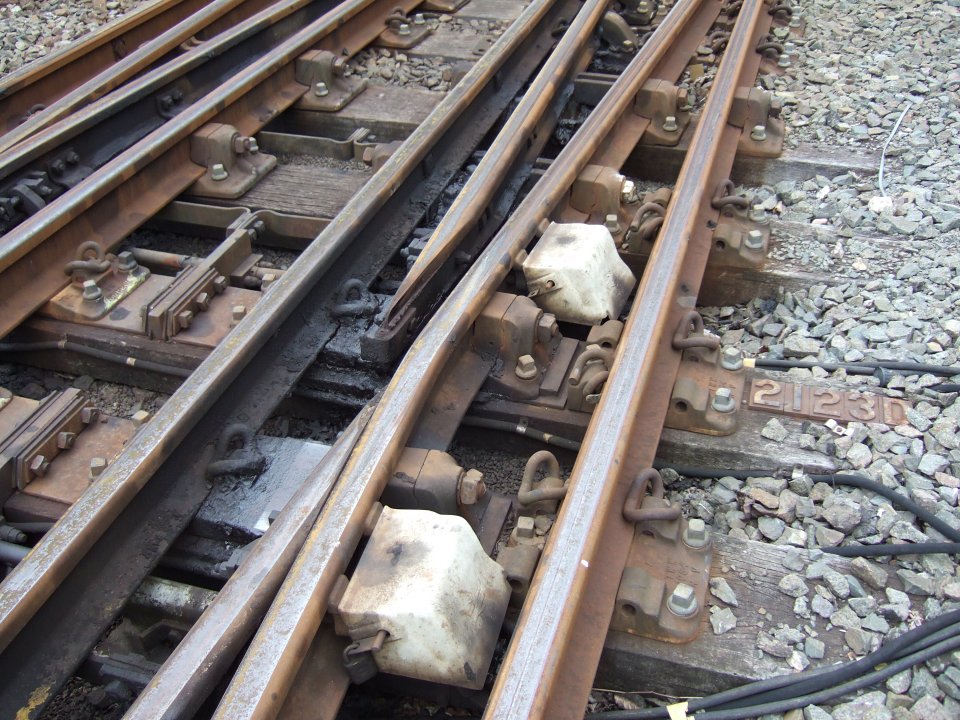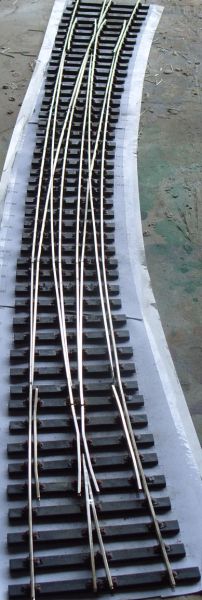Templot Club Archive 2007-2020
|
|||
| author | remove search highlighting | ||
|---|---|---|---|
|
posted: 4 Apr 2012 22:53 from: Jim Guthrie
click the date to link to this post click member name to view archived images |
I've just drawn up a double slip based on an irregular diamond. The "K" crossings are close to 1:8 - one just above and one just below. I have worries about there being problems with the "K" crossings because of the curves on both roads of the diamond - 7mm scale radii 5038mm/3763mm. I've had a thought about re-designing it with a switched diamond but is there a drawing of a slip with switched diamonds? I'm having problems trying to work in arrangements to anchor the switches of the diamond yet allow enough length for the rails to flex (bullhead rail) without encroaching on the slip switches. Or if switched diamonds did exist in slips, were the diamond switches relatively short with hinges? Jim. |
||
|
posted: 5 Apr 2012 21:22 from: mike47j click the date to link to this post click member name to view archived images |
http://acm.jhu.edu/~sthurmovik/Railpics/Towers/SHORE-double-slip.jpg Mike JOhnson |
||
|
posted: 5 Apr 2012 21:45 from: Martin Wynne
click the date to link to this post click member name to view archived images |
Thanks for the link, Mike. Here is an excellent picture from Mick Nicholson showing a flat-bottom double-slip with movable K-crossings: fb_movablek_dslip.jpg  © thanks to Mick Nicholson More: topic 1229 regards, Martin. |
||
|
posted: 5 Apr 2012 23:56 from: Tony W
click the date to link to this post click member name to view archived images |
Hi Martin. Kings Cross 25/12/72 with switched double slip to the right. Tony.2151_051855_070000000.jpg  |
||
|
posted: 6 Apr 2012 09:05 from: Jim Guthrie
click the date to link to this post click member name to view archived images |
Many thanks for the responses. Mike Johnson's picture answers my question about the lengths of the crossing switch blades - they are obbviously quite short and hinged in some way. I also note on mick Nicholson's picture of the flat-bottom switched diamond that the slip road has special slide chairs at the switch ends onto which the slip roads are clipped, but the slip roads are unclipped for the next two sleepers out from the switch ends. I might presume that bullhead arrangements might have been similar. I won't actually be building this track (it's for someone else) but I think I might have to think of some way of hingeing the short "K" switch blades. I'm more used to laying longer flexible switch blades. Jim. |
||
|
posted: 6 Apr 2012 09:08 from: Jim Guthrie
click the date to link to this post click member name to view archived images |
Correction. I've just looked at the Mick Nicholson picture again and seen the opposite slip rail is bolted to the slide chair. Jim. |
||
|
posted: 6 Apr 2012 10:50 from: Phil O
click the date to link to this post click member name to view archived images |
Jim Guthrie wroteI won't actually be building this track (it's for someone else) but I think I might have to think of some way of hingeing the short "K" switch blades. I'm more used to laying longer flexible switch blades.Hi Jim I use 1mm Phosphor Bronze strip to make the hinge on GW old style switches, I put it on the viewing side so that it looks like the two bolt fishplate the GW used. It sometime needs to be narrowed a bit to fit the rail web. If a heel chair is needed remove the portion of key which sticks out from the chair and then open up the resultant jaws so that the rail is a loose fit. HTH Phil Edit: Just noticed this for S7 where as I model in 4mm so a wider bit of strip will be needed. |
||
|
posted: 6 Apr 2012 12:00 from: Jim Guthrie
click the date to link to this post click member name to view archived images |
Phil O wrote: I use 1mm Phosphor Bronze strip to make the hinge on GW old style switches, I put it on the viewing side so that it looks like the two bolt fishplate the GW used. It sometime needs to be narrowed a bit to fit the rail web. If a heel chair is needed remove the portion of key which sticks out from the chair and then open up the resultant jaws so that the rail is a loose fit.Phil Thanks for the tips - I shall pass them on to the builder. It's actually being designed for 31.5mm gauge 7mm scale, not S7. Jim. |
||
|
posted: 6 Apr 2012 12:44 from: Nigel Brown click the date to link to this post click member name to view archived images |
Jim, I thought of various schemes when I decided to use GW loose heel switches, and experimented with one or two involving pivot either under a cosmetic chair or adjacent to one. In the end, I reverted to my usual approach of trying the simplest thing which one thinks may work; saves a lot of effort and there's less to go wrong! This was simply to whack the rail into the single non-slide chair at the switch end and rely on the natural flexibility of the chair to allow the rail to pivot. I have six turnouts built like this and they all work fine. I suspect what is happening is chair and rail both flexing a bit. I've seen no sign of a chair failing, but if one did it's a relatively simple matter to prise it off and push on a new one. One could make the fit of rail in chair a bit looser as per prototype; the easiest way of doing this may be to thin down the profile of the rail slightly. I'd suggest the builder does simple experiment to see if it would work in his case. Cheers Nigel |
||
|
posted: 6 Apr 2012 15:13 from: Jim Guthrie
click the date to link to this post click member name to view archived images |
Nigel Brown wrote: In the end, I reverted to my usual approach of trying the simplest thing which one thinks may work; saves a lot of effort and there's less to go wrong! This was simply to whack the rail into the single non-slide chair at the switch end and rely on the natural flexibility of the chair to allow the rail to pivot. I have six turnouts built like this and they all work fine. I suspect what is happening is chair and rail both flexing a bit.Nigel, Many thanks for that suggestion. I reckon that would work well - as you have proved. The builder is also a Templot owner so he might even be reading this thread. Jim. |
||
|
posted: 7 Apr 2012 07:43 from: MartynS
click the date to link to this post click member name to view archived images |
Hi Nigel and Jim, Yes it is me Martyn. |
||
|
posted: 10 Apr 2012 14:58 from: Stephen Freeman
click the date to link to this post click member name to view archived images |
Interestingly enough I have just built one of these in 0-MF. Photo is during course of construction pre-fitment of tiebars.142_100955_550000000.jpg |
||
| Please read this important note about copyright: Unless stated otherwise, all the files submitted to this web site are copyright and the property of the respective contributor. You are welcome to use them for your own personal non-commercial purposes, and in your messages on this web site. If you want to publish any of this material elsewhere or use it commercially, you must first obtain the owner's permission to do so. |